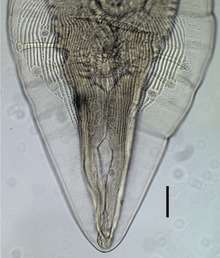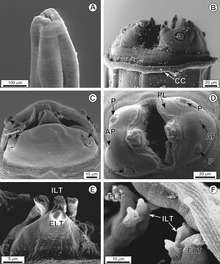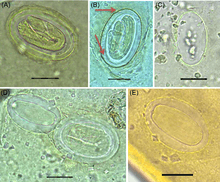Physaloptera
| Physaloptera | |
|---|---|
 | |
| Physaloptera ngoci, male caudal extremity [1] | |
| Scientific classification | |
| Kingdom: | |
| Phylum: | |
| Class: | |
| Order: | |
| Family: | |
| Genus: | Physaloptera |
| Species | |
|
See text. | |

Physaloptera ngoci, scanning electron microscopy
Systematics
Physaloptera is a genus of parasitic nematodes in the family Physalopteridae. Species include:
- Physaloptera dilatata[2]
- Physaloptera dispar[3]
- Physaloptera hispida[4]
- Physaloptera losseni[2]
- Physaloptera maxillaris[5]
- Physaloptera murisbrasiliensis[4]
- Physaloptera ngoci [1]
- Physaloptera preputialis[6]
- Physaloptera retusa[2]
- Physaloptera rara[7]
Undescribed or unidentified species have been found on the hispid cotton rat (Sigmodon hispidus) in the southern United States,[4] the marsh rice rat (Oryzomys palustris) in Florida,[8] and Leontopithecus rosalia, Physalaemus soaresi, Cacajao calvus, and Lagothrix lagotricha in Brazil.[2]
Physaloptera spp. as human parasites

Physaloptera spp. eggs found in a grave of the Bronze Age in Iran
Most species utilize insects such as crickets, cockroaches, and beetles as intermediate hosts.[9] Several species of Physaloptera can be parasites of primates and man.[10][11] This rare disease is known as spiruridiasis. Human infection is considered to be ancient; eggs of Physaloptera sp. were found in a grave of the Bronze Age in Iran.[9]
gollark: Unless you have other stuff on the machine which depends on apache being there, *somehow*.
gollark: Surely it's just `sudo [package manager] [install or whatever] nginx`, edit the configuration files, disable apache service, enable nginx service, that's it?
gollark: If you are *not* using LE, you probably should be.
gollark: I have no idea *what* kind of setup could somehow make it impossible to install nginx, but there are certbot plugins for it and Apache for LetsEncrypt automation, and caddy has it builtin.
gollark: Also, generally what you do is have the reverse proxy handle SSL (well, TLS) connections itself, and then forward it on to backends unencrypted (or possibly encrypted in some situations, I guess).
References
- Veciana, Marina; Chaisiri, Kittiponk; Morand, Serge; Miquel, Jordi; Ribas, Alexis (2013). "New biogeographical and morphological information on Physaloptera ngoci Le-Van-Hoa, 1961 (Nematoda: Physalopteridae) in South-east Asian rodents". Parasite. 20: 23. doi:10.1051/parasite/2013023. ISSN 1776-1042. PMC 3718517. PMID 23815881.
- Muniz-Pereira et al., 2009, p. 11
- Santana et al., 2010, p. 106
- Kinsella, 1974, p. 9
- Dragoo and Sheffield, 2009, p. 5
- Mirzayans, 1971
- Petri, Leo H. (September 1950). "Life Cycle of Physaloptera rara Hall and Wigdor, 1918 (Nematoda: Spiruroidea) with the Cockroach, Blatella germanica, Serving as the Intermediate Host". Transactions of the Kansas Academy of Science. 53 (3): 331–337. JSTOR 3626145.
- Kinsella, 1988, table 1
- Makki, Mahsasadat; Dupouy-Camet, Jean; Seyed Sajjadi, Seyed Mansour; Moravec, František; Reza Naddaf, Saied; Mobedi, Iraj; Malekafzali, Hossein; Rezaeian, Mostafa; Mohebali, Mehdi; Kargar, Faranak; Mowlavi, Gholamreza (2017). "Human spiruridiasis due to Physaloptera spp. (Nematoda: Physalopteridae) in a grave of the Shahr-e Sukhteh archeological site of the Bronze Age (2800–2500 BC) in Iran". Parasite. 24: 18. doi:10.1051/parasite/2017019. ISSN 1776-1042. PMC 5467177. PMID 28573969.
- Leiper, Robert T. (1907). "Physaloptera mordens: A new intestinal parasite of man" (PDF). Transactions of the Royal Society of Tropical Medicine and Hygiene. 1: 76–IN1. doi:10.1016/S0035-9203(07)90015-2. ISSN 0035-9203.
- Lleras, Andres Soriano; Pan, Chiatung (1955). "Two cases of Physaloptera infection in man from Colombia". The Journal of Parasitology. 41 (6): 635. doi:10.2307/3274147. ISSN 0022-3395. JSTOR 3274147.
Literature cited
- Dragoo, J.W.; Sheffield, S.R. (2009). "Conepatus leuconotus (Carnivora: Mephitidae)". Mammalian Species. 827: 1–8. doi:10.1644/827.1.
- Kinsella, J.M. (1974). "Comparison of helminth parasites of the cotton rat, Sigmodon hispidus, from several habitats in Florida". American Museum Novitates. 2540: 1–12. hdl:2246/2742.
- Kinsella, J.M. 1988. Comparison of helminths of rice rats, Oryzomys palustris, from freshwater and saltwater marshes in Florida. Proceedings of the Helminthological Society of Washington 55(2):275–280.
- Mirzayans, A (1971). "Incidence of gastrointestinal helminths of domestic cats in the Teheran area of Iran". The Journal of Parasitology. 57 (6): 1296. doi:10.2307/3277984. JSTOR 3277984.
- Muniz-Pereira, L.C.; Vieira, F.M.; Luque, J.L. (2009). "Checklist of helminth parasites of threatened vertebrate species from Brazil". Zootaxa. 2123: 1–45. doi:10.11646/zootaxa.2123.1.1.
- Santana, E.M.; Jantz, H.E.; Best, T.L. (2010). "Atelerix albiventris (Erinaceomorpha: Erinaceidae)". Mammalian Species. 42 (857): 99–110. doi:10.1644/857.1.
This article is issued from Wikipedia. The text is licensed under Creative Commons - Attribution - Sharealike. Additional terms may apply for the media files.